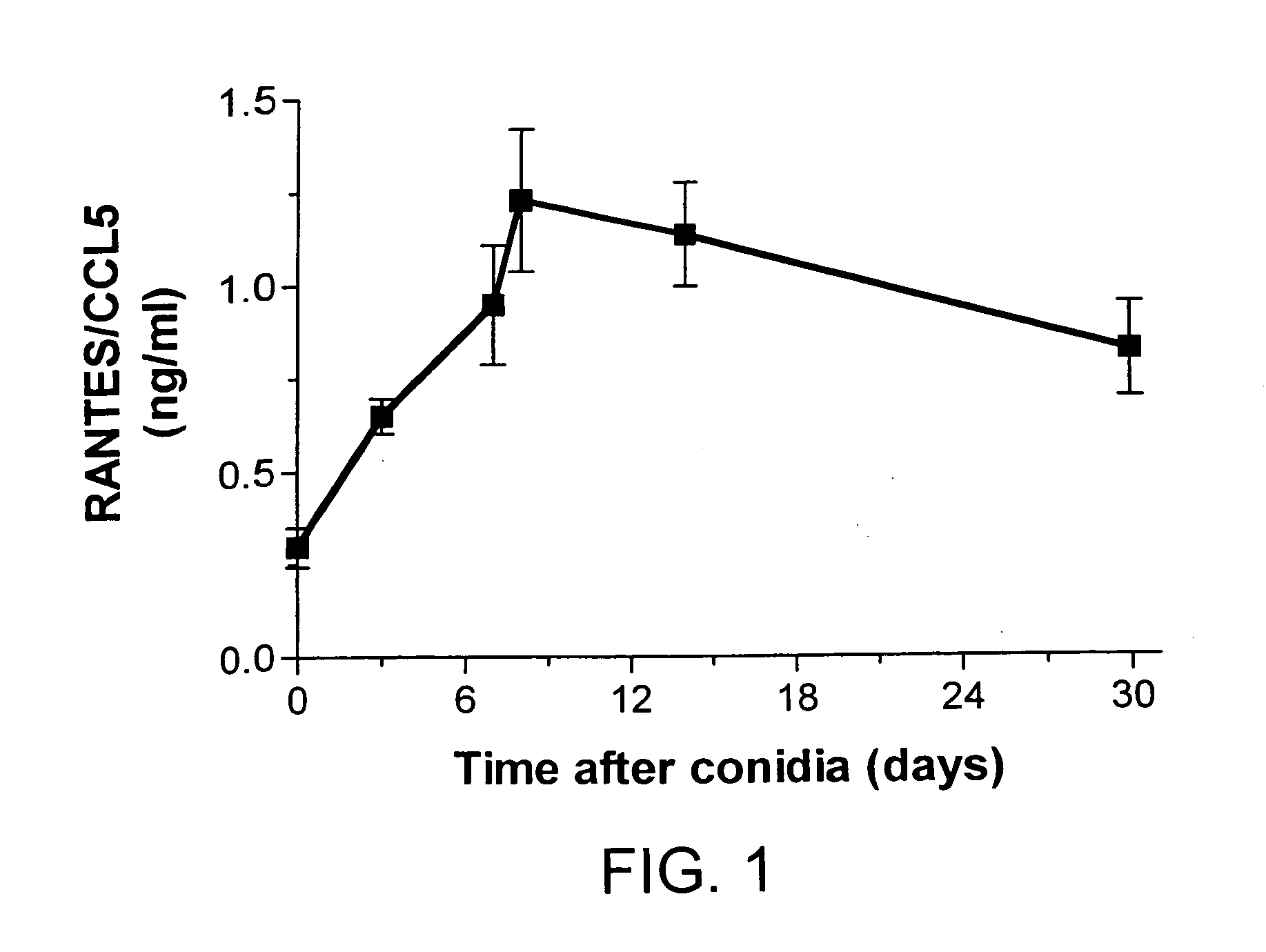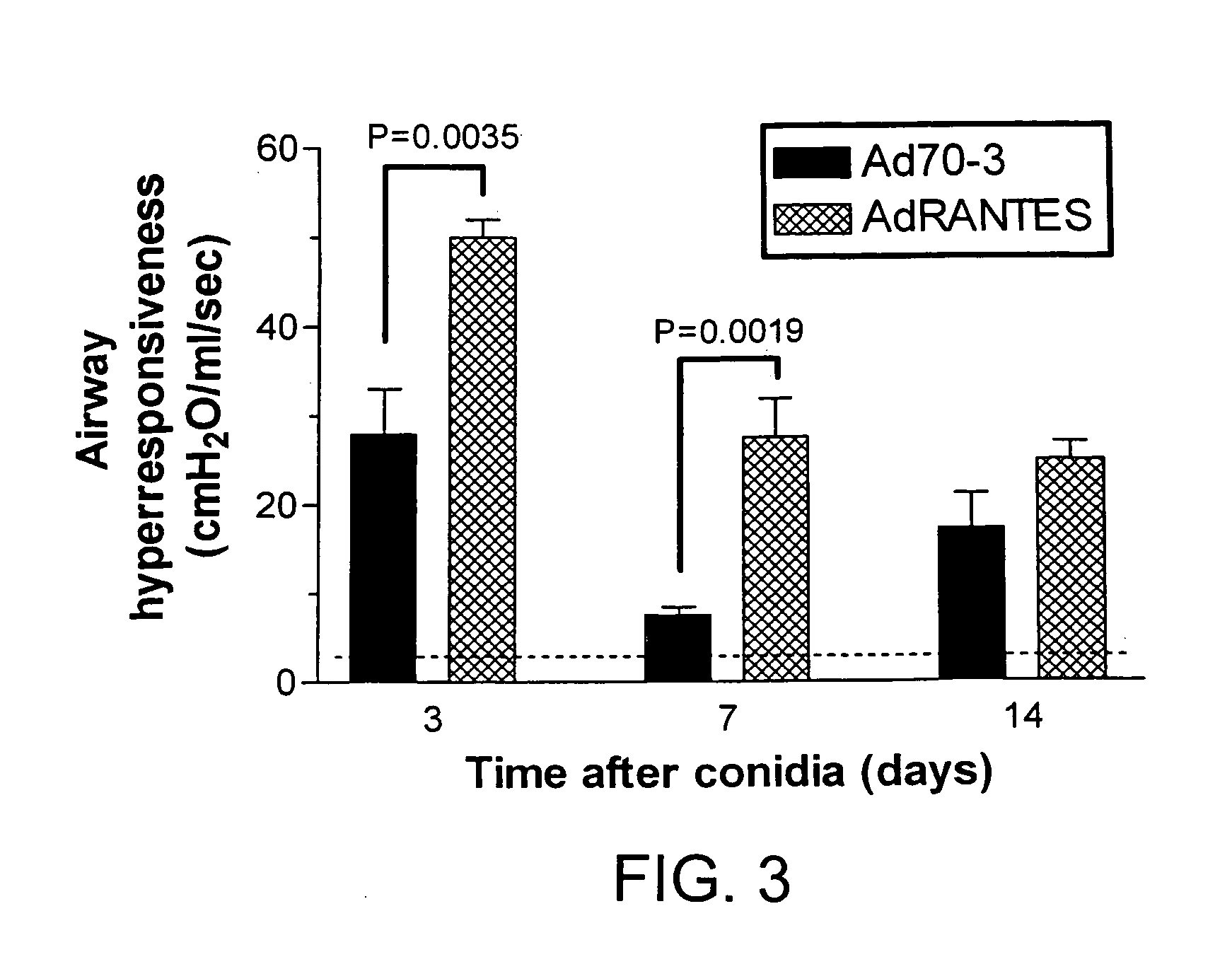Method of treating allergen induced airway disease
a technology of allergens and airways, applied in the field of inflammatory airway disease, can solve the problems of chronic inflammation, inability to reverse established allergic airway remodeling, inflammation and damage to the mucosa,
- Summary
- Abstract
- Description
- Claims
- Application Information
AI Technical Summary
Problems solved by technology
Method used
Image
Examples
example 1
Temporal Changes in Whole Lung Levels of RANTES / CCL5 Protein Levels Following Conidia Challenge in A. fumigatus-Sensitized Mice
[0111] In this example, it was determined whether RANTES / CCL5 levels in bronchoalveolar lavage (BAL) and whole lung samples were altered during the course of chronic allergic airway disease. Several time points were examined in order to develop a detailed picture of the temporal changes in this chemokine over the 30 days following conidia introduction into A. fumigatus-sensitized mice. ELISA analysis of RANTES / CCL5 in whole lung homogenates from A. fumigatus-sensitized mice challenged with A. fumigatus conidia are shown in FIG. 1. At all times examined after the conidia challenge, whole lung levels of RANTES / CCL5 were significantly (P.ltoreq.0.05) increased above levels measured immediately prior to the conidia challenge (i.e. baseline levels; FIG. 1). The highest levels of RANTES / CCL5 were detected at day 8 after the conidia challenge. RANTES / CCL5 was not d...
example 2
Temporal Changes in BAL and Whole Lung Levels of RANTES / CCL5 Protein Levels Following Ad RANTES and Conidia Challenge in A. fumigatus-Sensitized Mice
[0112] In this example it was determined whether adenovirus-mediated overexpression of murine RANTES / CCL5 (AdRANTES) altered any of the features of this allergic airway disease model. Previous studies showed that the intratracheal administration of AdRANTES induced the expression of RANTES / CCL5 in the bronchial epithelium and significantly increased RANTES / CCL5 levels in the lungs of naive rats for up to 7 days after adenovirus administration (32). As shown in FIG. 2, the presence of AdRANTES significantly increased the immunoreactive levels of RANTES / CCL5 in BAL samples (top panel, FIG. 2) and whole lungs (bottom panel, FIG. 2) compared with levels of this chemokine measured in BAL and lung samples from mice exposed to Ad70-3 at day 3 after the conidia challenge. However at days 7 and 14 after conidia, no differences in RANTES / CCL5 lev...
example 3
Adenoviral-Mediated Over Expression of RANTES / CCL5 Markedly Augmented the Airway Hyperresponsiveness Associated with Chronic Allergic Airway Disease
[0113] This example examines the effect of RANTES / CCL5 overexpression in chronic allergic airway disease.
[0114] Although several studies have documented that RANTES / CCL5 levels are significantly increased during clinical asthma, the relative contribution of this chemokine to changes in airway responsiveness is still undefined. Experimental studies to date have not completely resolved the role of RANTES / CCL5 in this response either, as RANTES / CCL5 contributes to the airway hyperreactivity associated with A. fumigatus (29) and OVA (28) but not that associated with S. mansoni egg antigen (27). A. fumigatus-sensitized mice that received the AdRANTES vector at the time of the bolus intratracheal conidia challenge exhibited significantly increased methacholine-induced airway hyperresponsiveness at days 3 and 7 of this model compared with simil...
PUM
| Property | Measurement | Unit |
|---|---|---|
| body weight | aaaaa | aaaaa |
| time | aaaaa | aaaaa |
| time | aaaaa | aaaaa |
Abstract
Description
Claims
Application Information
 Login to View More
Login to View More - R&D
- Intellectual Property
- Life Sciences
- Materials
- Tech Scout
- Unparalleled Data Quality
- Higher Quality Content
- 60% Fewer Hallucinations
Browse by: Latest US Patents, China's latest patents, Technical Efficacy Thesaurus, Application Domain, Technology Topic, Popular Technical Reports.
© 2025 PatSnap. All rights reserved.Legal|Privacy policy|Modern Slavery Act Transparency Statement|Sitemap|About US| Contact US: help@patsnap.com



